Numerical Simulation of Flashing Flows in a Converging–Diverging Nozzle with Interfacial Area Transport Equation
Abstract
1. Introduction
2. Mathematical Model
2.1. Two-Fluid Model
2.2. Main Closure Models
2.3. Interfacial Area Transport Equation
2.4. Computational Grid and Boundary Conditions
3. Results and Discussion
3.1. Effect of Inlet Mass Flow Rate
3.2. Axial Distribution of Physical Fields
3.3. Radial Distribution of Physical Fields
4. Conclusions
Author Contributions
Funding
Data Availability Statement
Conflicts of Interest
Nomenclature
| Latin symbols | ||
| A | Interfacial area concentration | 1/m |
| d | Bubble diameter | m |
| F | Momentum source term | kg/(m2·s2) |
| f | Departure frequency | 1/s |
| H | Enthalpy | J/(kg·K) |
| h | Heat transfer coefficient | W/(m2·K) |
| J | Nucleation rate | 1/(m3·s) |
| K | Kinetic energy | J/(kg·K) |
| N | Nucleation site density | 1/m3 |
| p | Pressure | Pa |
| Q | Energy source term | W/(m3·K) |
| r | Bubble radius | m |
| S | Surface area | m2 |
| T | Temperature | K |
| u | Velocity | m/s |
| V | Volume | m3 |
| Greek symbols | ||
| α | Volume fraction | |
| Γ | Mass source term | kg/(m3·s) |
| μ | Dynamic viscosity | Pa·s |
| ρ | Density | kg/m3 |
| φ | Bubble shape factor | |
| ϕ | Increase rate of bubble number density | 1/(m3·s) |
| Subscripts and indices | ||
| B | Bubble breakup | |
| C | Bubble coalescence | |
| c | Critical value | |
| dep | Departure | |
| e | Equivalent value | |
| g | Gas phase | |
| HET | Heterogeneous nucleation | |
| l | Liquid phase | |
| N | Nucleation | |
| P | Phase change | |
| sm | Sauter mean value | |
| T | Thermal phase change | |
| turb | Turbulence | |
| w | Wall | |
| Abbreviations | ||
| CBD | Constant Bubble Diameter | |
| CBND | Constant Bubble Number Density | |
| CFD | Computational Fluid Dynamics | |
| EXP | Experiment | |
| IATE | Interfacial Area Transport Equation | |
| LOCA | Loss of Coolant Aaccident | |
| PBM | Population Balance Model | |
| TFM | Two-Fluid Model | |
| Dimensionless number | ||
| Ja | Jakob number | |
| Nu | Nusselt number | |
| Pe | Péclet number | |
| Pr | Prandtl number | |
| Re | Reynolds number | |
References
- Li, J.; Liao, Y.; Bolotnov, I.A.; Zhou, P.; Lucas, D.; Li, Q.; Gong, L. Direct numerical simulation of heat transfer on a deformable vapor bubble rising in superheated liquid. Phys. Fluids 2023, 35, 023319. [Google Scholar] [CrossRef]
- Lv, H.; Wang, Y.; Wu, L.; Hu, Y. Numerical simulation and optimization of the flash chamber for multi-stage flash seawater desalination. Desalination 2019, 465, 69–78. [Google Scholar] [CrossRef]
- Sonawan, H.; Nurhidayat, D.; Saefudin, H. Influence of wall atomizer to condensation rate in flashing purification. Water Pract. Technol. 2019, 14, 872–883. [Google Scholar] [CrossRef]
- Luo, C.; Huang, L.; Gong, Y.; Ma, W. Thermodynamic comparison of different types of geothermal power plant systems and case studies in China. Renew. Energy 2012, 48, 155–160. [Google Scholar] [CrossRef]
- Eboli, M.; Forgione, N.; Del Nevo, A. Assessment of SIMMER-III code in predicting Water Cooled Lithium Lead Breeding Blanket “in-box-Loss of Coolant Accident”. Fusion Eng. Des. 2021, 163, 112127. [Google Scholar] [CrossRef]
- Yu, H.; Chen, Z.; Cai, J. Accident tolerant fuel thermal hydraulic behaviors evaluation during loss of coolant accident in CPR1000. Ann. Nucl. Energy 2020, 139, 107273. [Google Scholar] [CrossRef]
- Liao, Y.; Lucas, D. A review on numerical modelling of flashing flow with application to nuclear safety analysis. Appl. Therm. Eng. 2021, 182, 116002. [Google Scholar] [CrossRef]
- Liao, Y.; Lucas, D. Possibilities and Limitations of CFD Simulation for Flashing Flow Scenarios in Nuclear Applications. Energies 2017, 10, 139. [Google Scholar] [CrossRef]
- Al-Fulaij, H.; Cipollina, A.; Micale, G.; Ettouney, H.; Bogle, D. Eulerian-Eulerian modelling and computational fluid dynamics simulation of wire mesh demisters in MSF plants. Eng. Comput. 2014, 31, 1242–1260. [Google Scholar] [CrossRef]
- Zhao, Y.; Peng, M.; Xu, Y.; Xia, G. Simulation investigation on flashing-induced instabilities in a natural circulation system. Ann. Nucl. Energy 2020, 144, 107561. [Google Scholar] [CrossRef]
- Liao, Y.; Lucas, D. 3D CFD simulation of flashing flows in a converging-diverging nozzle. Nucl. Eng. Des. 2015, 292, 149–163. [Google Scholar] [CrossRef]
- Frank, T. Simulation of Flashing and Steam Condensation in Subcooled Liquid Using ANSYS CFX. In Proceedings of the Fifth FZD & ANSYS MPF Workshop, Dresden, Germany, 25–27 April 2007; pp. 1–29. [Google Scholar]
- Janet, J.P.; Liao, Y.; Lucas, D. Heterogeneous nucleation in CFD simulation of flashing flows in converging-diverging nozzles. Int. J. Multiph. Flow 2015, 74, 106–117. [Google Scholar] [CrossRef]
- Hibiki, T.; Ishii, M. Active nucleation site density in boiling systems. Int. J. Heat Mass Transf. 2003, 46, 2587–2601. [Google Scholar] [CrossRef]
- Marsh, C.A.; O’Mahony, A.P. Three-dimensional modelling of industrial flashing flows. Prog. Comput. Fluid Dyn. Int. J. 2009, 9, 393. [Google Scholar] [CrossRef]
- Liao, Y.; Lucas, D. Numerical analysis of flashing pipe flow using a population balance approach. Int. J. Heat Fluid Flow 2019, 77, 299–313. [Google Scholar] [CrossRef]
- Pinhasi, G.A.; Ullmann, A.; Dayan, A. MODELING OF FLASHING TWO-PHASE FLOW. Rev. Chem. Eng. 2005, 21, 133–264. [Google Scholar] [CrossRef]
- Li, J.; Liao, Y.; Zhou, P.; Lucas, D.; Li, Q. Numerical study of flashing pipe flow using a TFM-PBM coupled method: Effect of interfacial heat transfer and bubble coalescence and breakup. Int. J. Therm. Sci. 2023, 193, 108504. [Google Scholar] [CrossRef]
- Shin, T.S.; Jones, O.C. Nucleation and flashing in nozzles-1. A distributed nucleation model. Int. J. Multiph. Flow 1993, 19, 943–964. [Google Scholar] [CrossRef]
- Plesset, M.S.; Zwick, S.A. The growth of vapor bubbles in superheated liquids. J. Appl. Phys. 1954, 25, 493–500. [Google Scholar] [CrossRef]
- Ranz, W.E.; Marshall, R. Evaporation from drops 1. Chem. Eng. Prog. 1952, 48, 173–180. [Google Scholar]
- Li, J.; Liao, Y.; Lucas, D.; Zhou, P. Stability analysis of discrete population balance model for bubble growth and shrinkage. Int. J. Numer. Methods Fluids 2021, 93, 3338–3363. [Google Scholar] [CrossRef]
- Ma, T.; Santarelli, C.; Ziegenhein, T.; Lucas, D.; Fröhlich, J. Direct numerical simulation–based Reynolds-averaged closure for bubble-induced turbulence. Phys. Rev. Fluids 2017, 2, 034301. [Google Scholar] [CrossRef]
- Liao, Y.; Krepper, E.; Lucas, D. A baseline closure concept for simulating bubbly flow with phase change: A mechanistic model for interphase heat transfer coefficient. Nucl. Eng. Des. 2019, 348, 1–13. [Google Scholar] [CrossRef]
- Liao, Y.; Ma, T.; Krepper, E.; Lucas, D.; Fröhlich, J. Application of a novel model for bubble-induced turbulence to bubbly flows in containers and vertical pipes. Chem. Eng. Sci. 2019, 202, 55–69. [Google Scholar] [CrossRef]
- Ishii, M.; Zuber, N. Drag coefficient and relative velocity in bubbly, droplet or particulate flows. AIChE J. 1979, 25, 843–855. [Google Scholar] [CrossRef]
- Tomiyama, A.; Tamai, H.; Zun, I.; Hosokawa, S. Transverse migration of single bubbles in simple shear flows. Chem. Eng. Sci. 2002, 57, 1849–1858. [Google Scholar] [CrossRef]
- Hosokawa, S.; Tomiyama, A.; Misaki, S.; Hamada, T. Lateral migration of single bubbles due to the presence of wall. Am. Soc. Mech. Eng. Fluids Eng. Div. FED 2002, 257, 855–860. [Google Scholar] [CrossRef]
- Burns, A.D.; Frank, T.; Hamill, I.; Shi, J.M. The Favre averaged drag model for turbulent dispersion in Eulerian multi-phase flows. In Proceedings of the 5th International Conference on Multiphase Flow, Yokohama, Japan, 30 May–4 June 2004; pp. 1–17. [Google Scholar]
- Menter, F.R. Two-equation eddy-viscosity turbulence models for engineering applications. AIAA J. 1994, 32, 1598–1605. [Google Scholar] [CrossRef]
- Ishii, M.; Kim, S.; Uhle, J. Interfacial area transport equation: Model development and benchmark experiments. Int. J. Heat Mass Transf. 2002, 45, 3111–3123. [Google Scholar] [CrossRef]
- Hibiki, T.; Ho Lee, T.; Young Lee, J.; Ishii, M. Interfacial area concentration in boiling bubbly flow systems. Chem. Eng. Sci. 2006, 61, 7979–7990. [Google Scholar] [CrossRef]
- Hibiki, T.; Ishii, M. Development of one-group interfacial area transport equation in bubbly flow systems. Int. J. Heat Mass Transf. 2002, 45, 2351–2372. [Google Scholar] [CrossRef]
- Ooi, Z.J.; Brooks, C.S. Two-group interfacial area transport equation coupled with void transport equation in adiabatic steam water flows. Int. J. Heat Mass Transf. 2021, 177, 121531. [Google Scholar] [CrossRef]
- Fu, X.Y.; Ishii, M. Two-group interfacial area transport in vertical air-water flow—I. Mechanistic model. Nucl. Eng. Des. 2003, 219, 143–168. [Google Scholar] [CrossRef]
- Blinkov, V.N.; Jones, O.C.; Nigmatulin, B.I. Nucleation and flashing in nozzles-2. Comparison with experiments using a five-equation model for vapor void development. Int. J. Multiph. Flow 1993, 19, 965–986. [Google Scholar] [CrossRef]
- Abuaf, N.; Wu, B.J.C.; Zimmer, G.A.; Saha, P. Study of Nonequilibrium Flashing of Water in a Converging-Diverging Nozzle; Volume 1: Experimental; Brookhaven National Lab.: Upton, NY, USA, 1981. [Google Scholar]

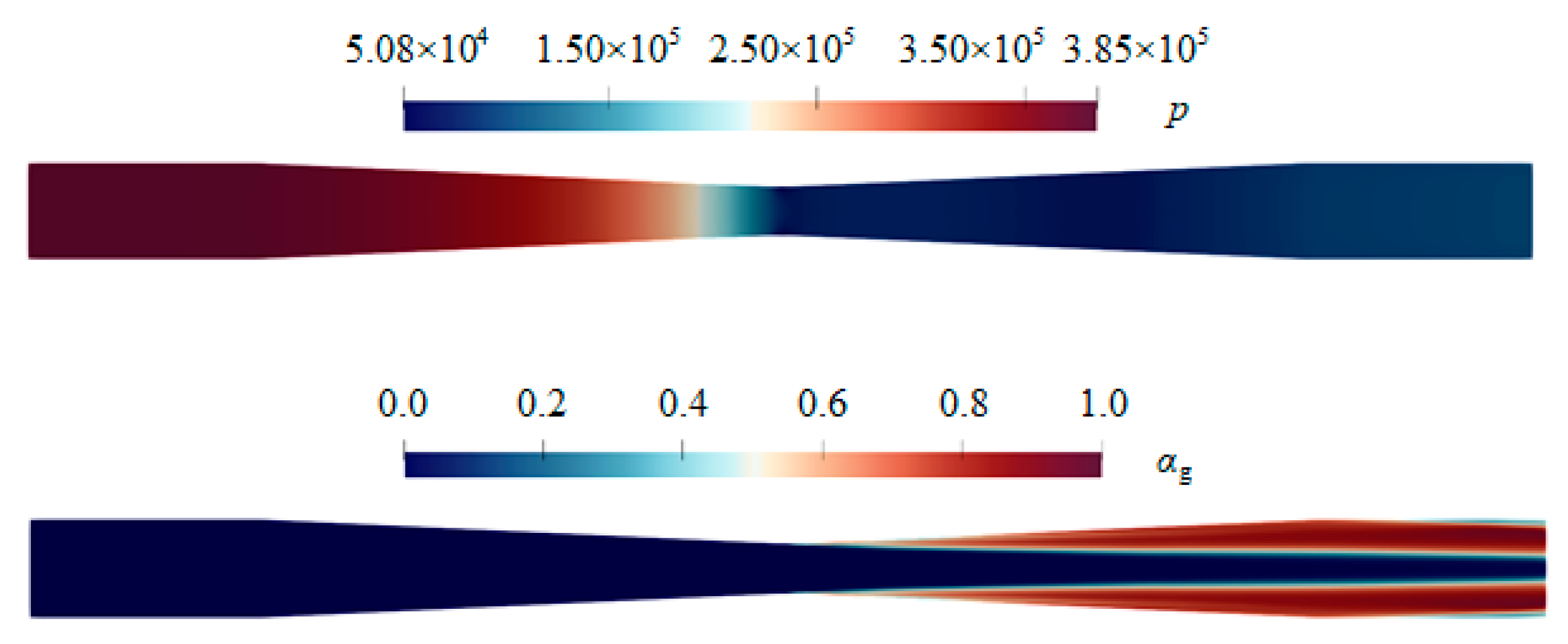
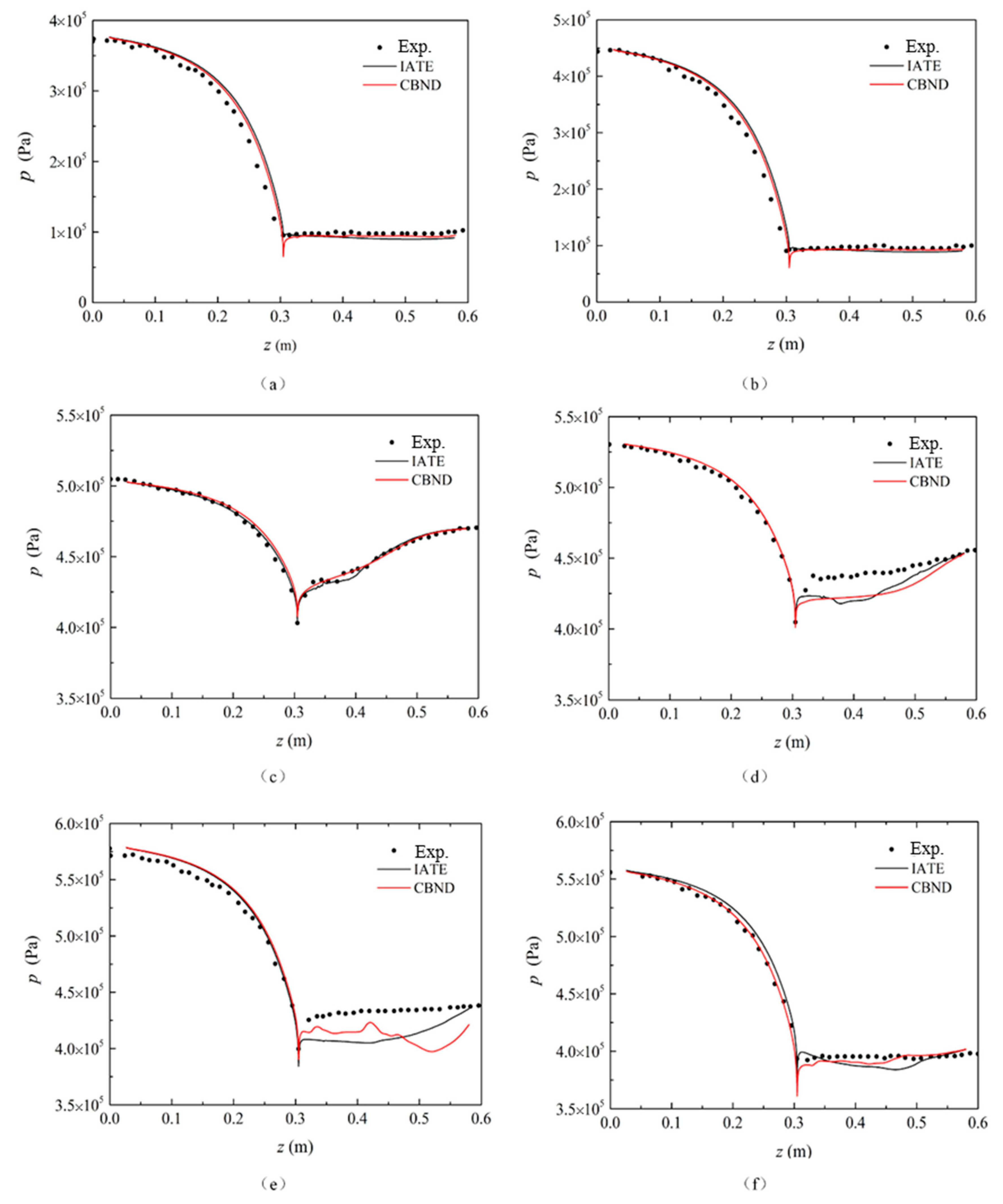
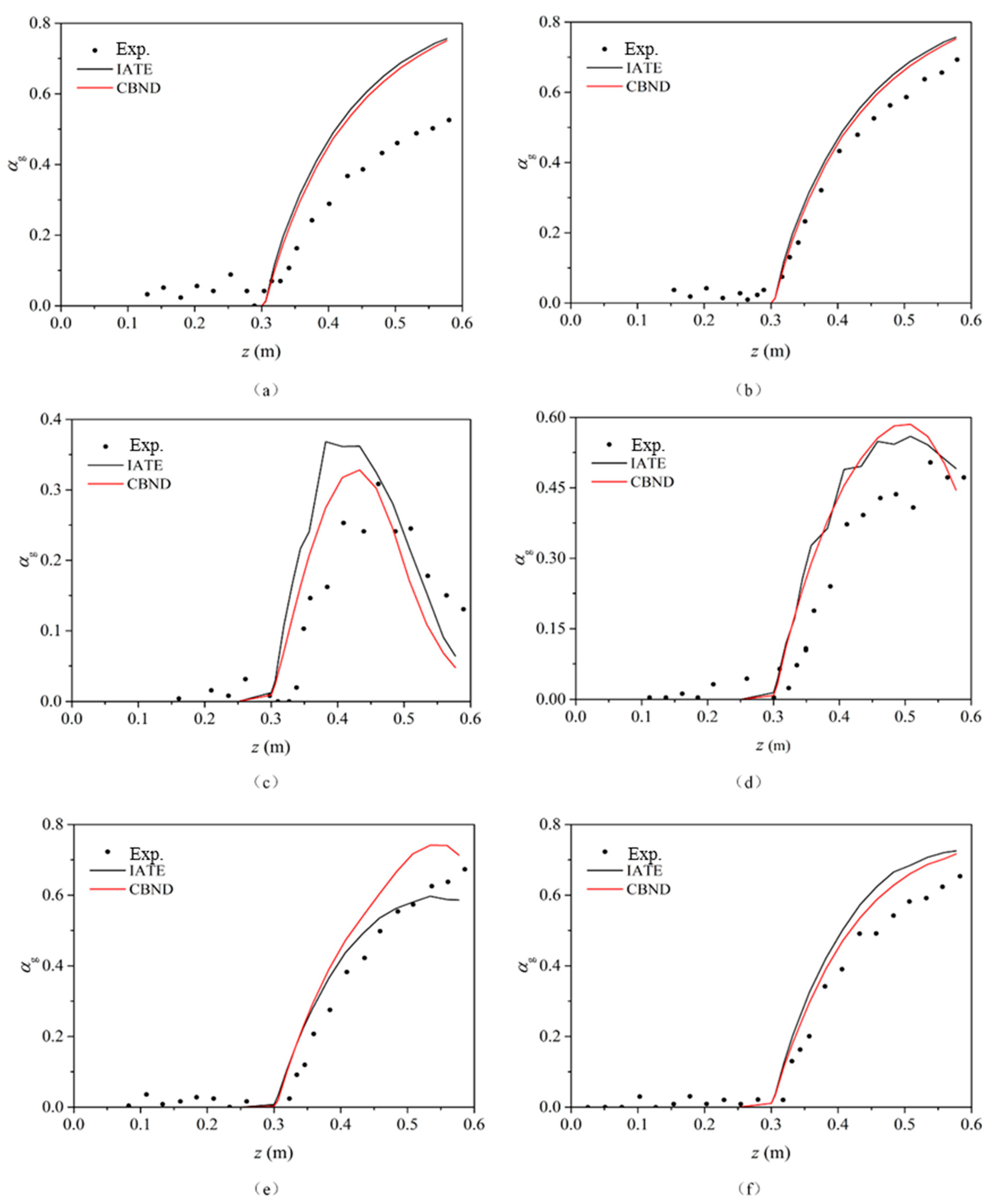

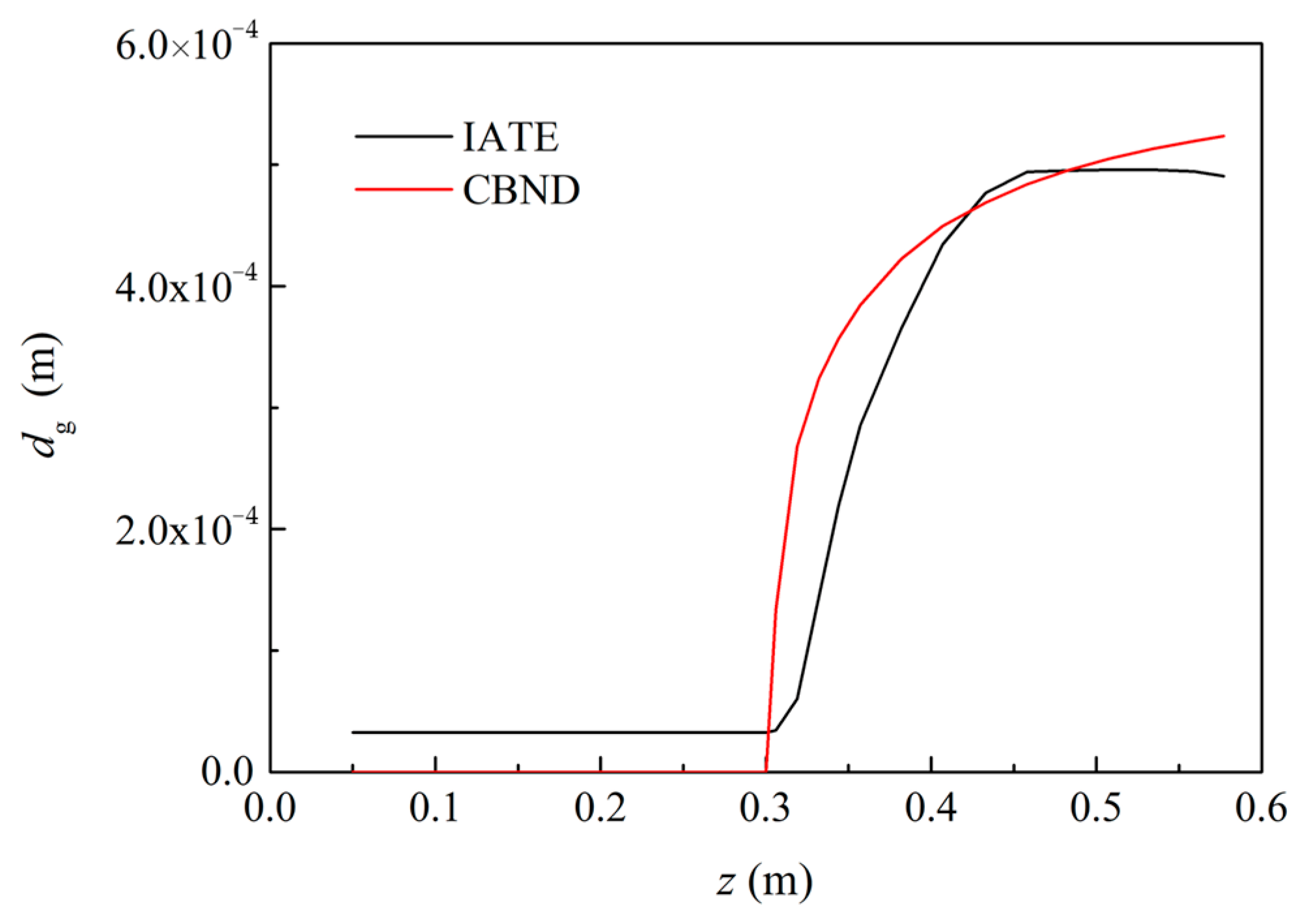
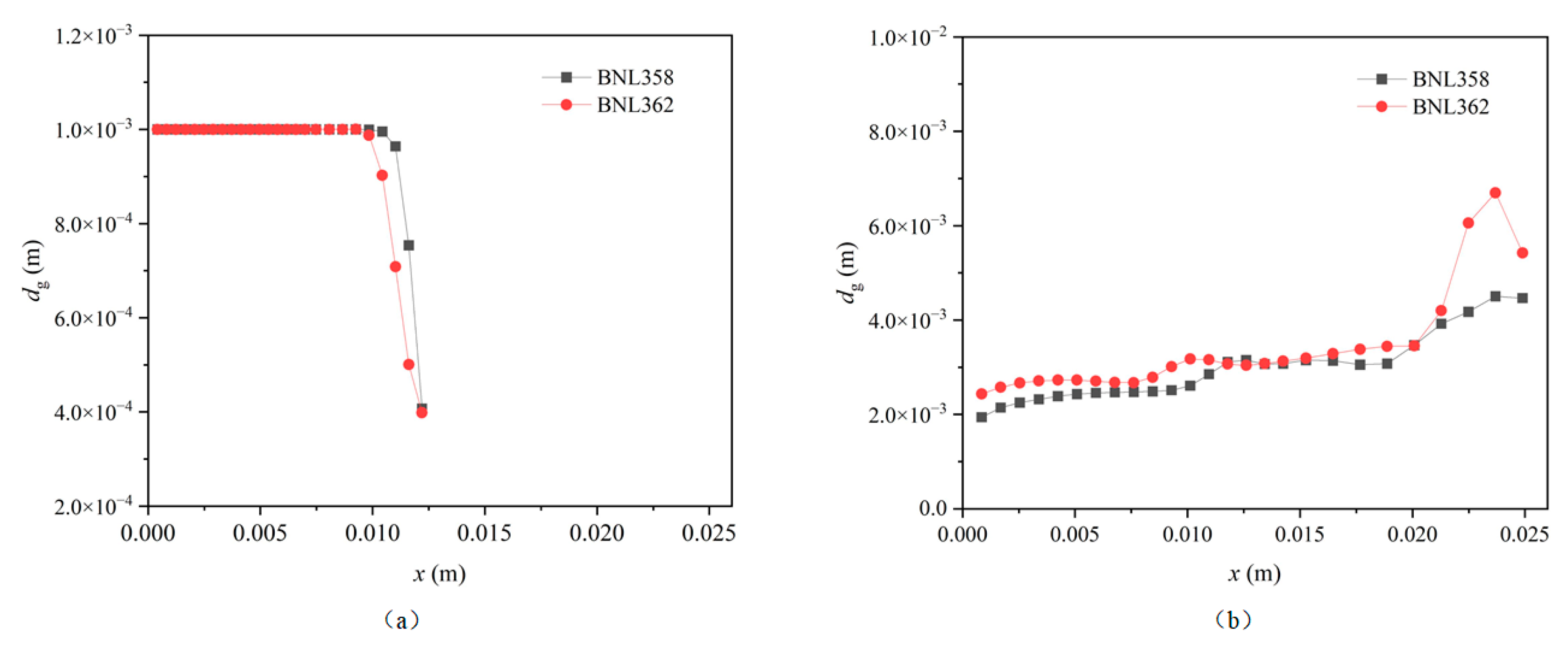
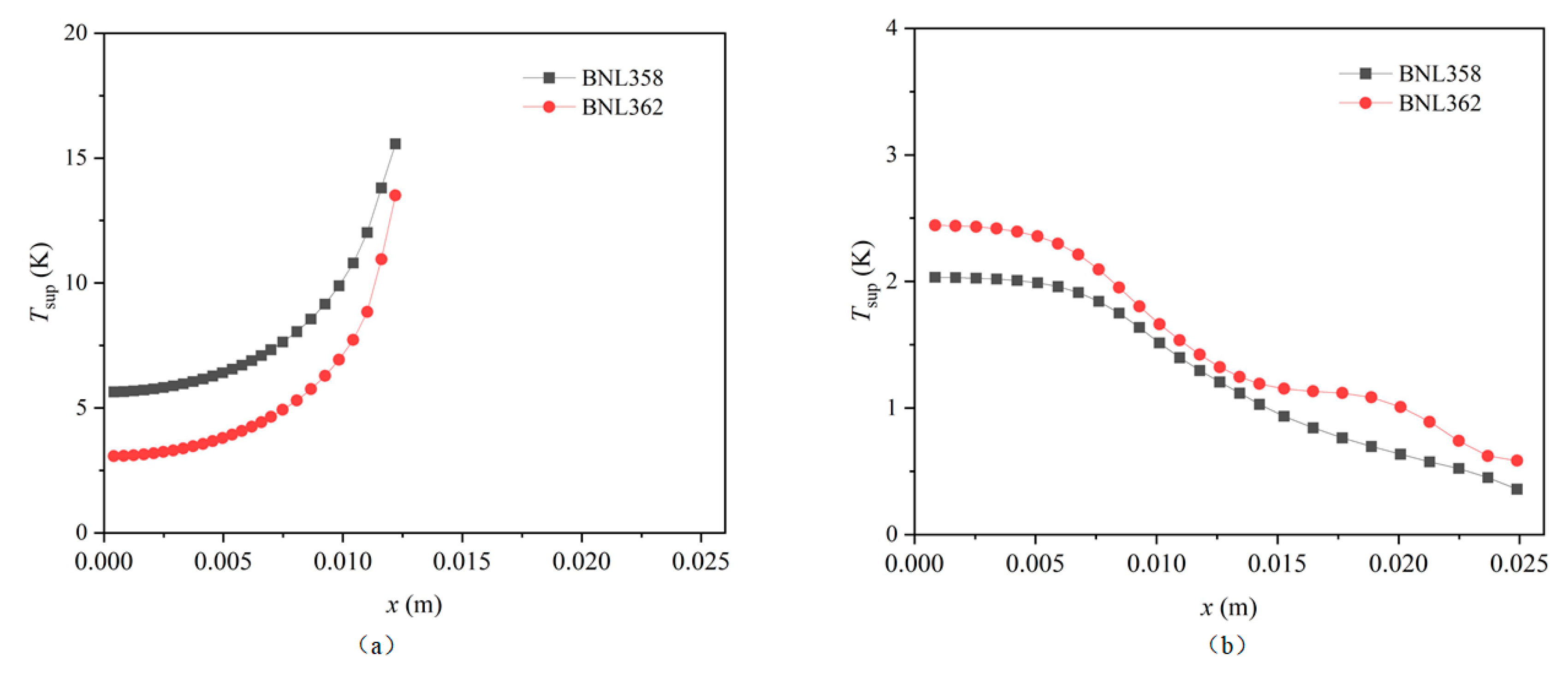
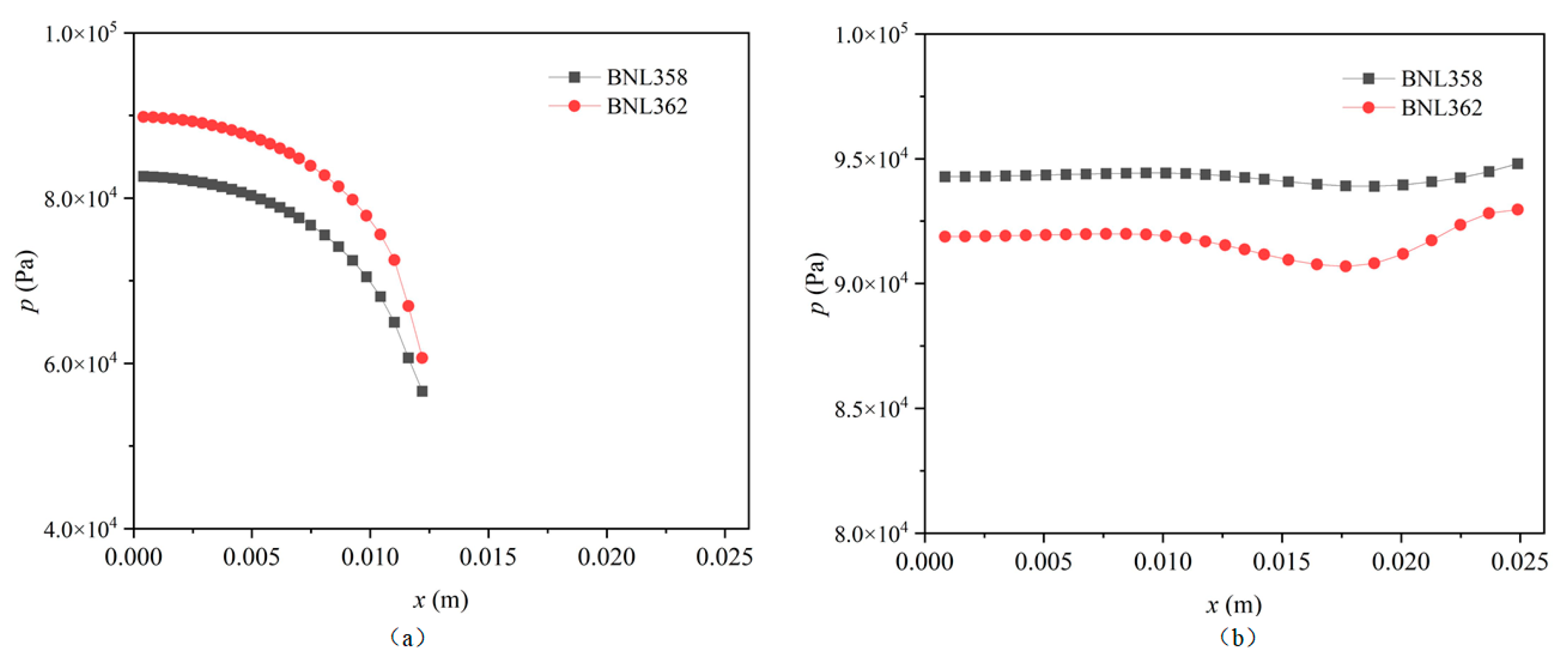
| Term | Reference | |
|---|---|---|
| Interfacial force | Drag force | Ishii and Zuber [26] |
| Lift force | Tomiyama et al. [27] | |
| Wall force | Hosokawa et al. [28] | |
| Turbulent dispersion force | Burns et al. [29] | |
| Virtual force | Constant virtual mass coefficient, Cvm = 0.5 | |
| Turbulence | Liquid | k-ω SST [30] |
| BIT | Ma et al. [23] | |
| Case | /kg·s−1 | /K | ||||
|---|---|---|---|---|---|---|
| BNL358 | 12.1 | 373.15 | 373.5 | 101.2 | 95 | 1 × 1010 |
| BNL362 | 13.7 | 372.85 | 443.4 | 101.2 | 92.9 | 1 × 1010 |
| BNL291 | 6.4 | 422.05 | 502 | 470 | 403 | 1 × 1010 |
| BNL284 | 7.3 | 422.35 | 530 | 456 | 404.7 | 2 × 1010 |
| BNL304 | 8.8 | 422.15 | 577.7 | 441 | 399.7 | 4 × 1010 |
| BNL309 | 8.8 | 422.25 | 555.9 | 402.5 | 393.5 | 5 × 109 |
| Case | /kg·s−1 | Error/% | |||
|---|---|---|---|---|---|
| Exp. | IATE | CBND | IATE | CBND | |
| BNL358 | 12.1 | 11.38 | 11.49 | −5.93 | −5.36 |
| BNL362 | 13.7 | 12.82 | 12.87 | −6.45 | −6.06 |
| BNL291 | 6.4 | 5.91 | 5.60 | −7.62 | −7.82 |
| BNL284 | 7.3 | 6.92 | 6.90 | −5.21 | −5.36 |
| BNL304 | 8.8 | 8.60 | 8.45 | −2.30 | −3.98 |
| BNL309 | 8.8 | 8.44 | 8.48 | −4.07 | −3.63 |
Disclaimer/Publisher’s Note: The statements, opinions and data contained in all publications are solely those of the individual author(s) and contributor(s) and not of MDPI and/or the editor(s). MDPI and/or the editor(s) disclaim responsibility for any injury to people or property resulting from any ideas, methods, instructions or products referred to in the content. |
© 2023 by the authors. Licensee MDPI, Basel, Switzerland. This article is an open access article distributed under the terms and conditions of the Creative Commons Attribution (CC BY) license (https://creativecommons.org/licenses/by/4.0/).
Share and Cite
Li, J.; Liao, Y.; Zhou, P.; Lucas, D.; Gong, L. Numerical Simulation of Flashing Flows in a Converging–Diverging Nozzle with Interfacial Area Transport Equation. Processes 2023, 11, 2365. https://doi.org/10.3390/pr11082365
Li J, Liao Y, Zhou P, Lucas D, Gong L. Numerical Simulation of Flashing Flows in a Converging–Diverging Nozzle with Interfacial Area Transport Equation. Processes. 2023; 11(8):2365. https://doi.org/10.3390/pr11082365
Chicago/Turabian StyleLi, Jiadong, Yixiang Liao, Ping Zhou, Dirk Lucas, and Liang Gong. 2023. "Numerical Simulation of Flashing Flows in a Converging–Diverging Nozzle with Interfacial Area Transport Equation" Processes 11, no. 8: 2365. https://doi.org/10.3390/pr11082365
APA StyleLi, J., Liao, Y., Zhou, P., Lucas, D., & Gong, L. (2023). Numerical Simulation of Flashing Flows in a Converging–Diverging Nozzle with Interfacial Area Transport Equation. Processes, 11(8), 2365. https://doi.org/10.3390/pr11082365








